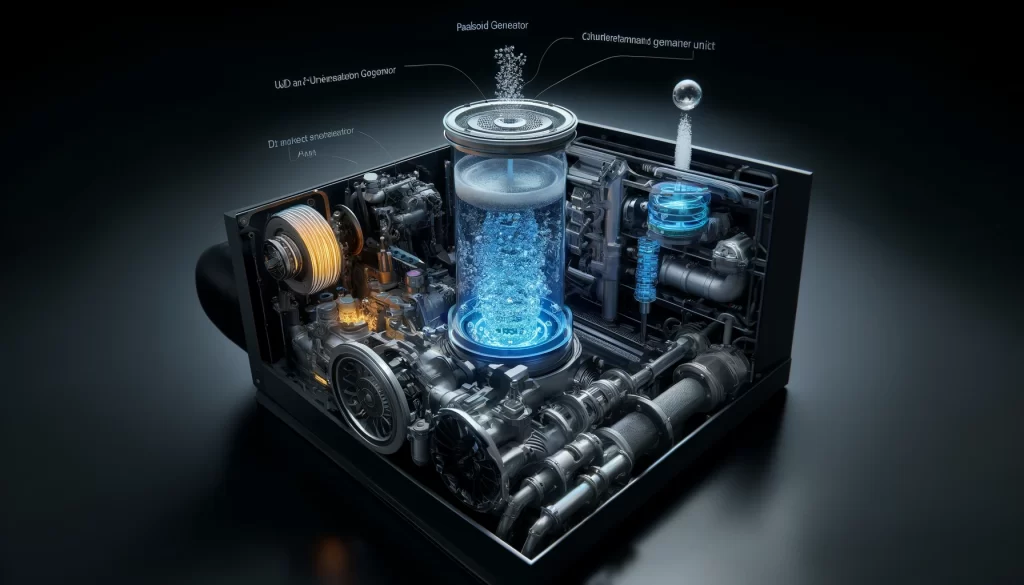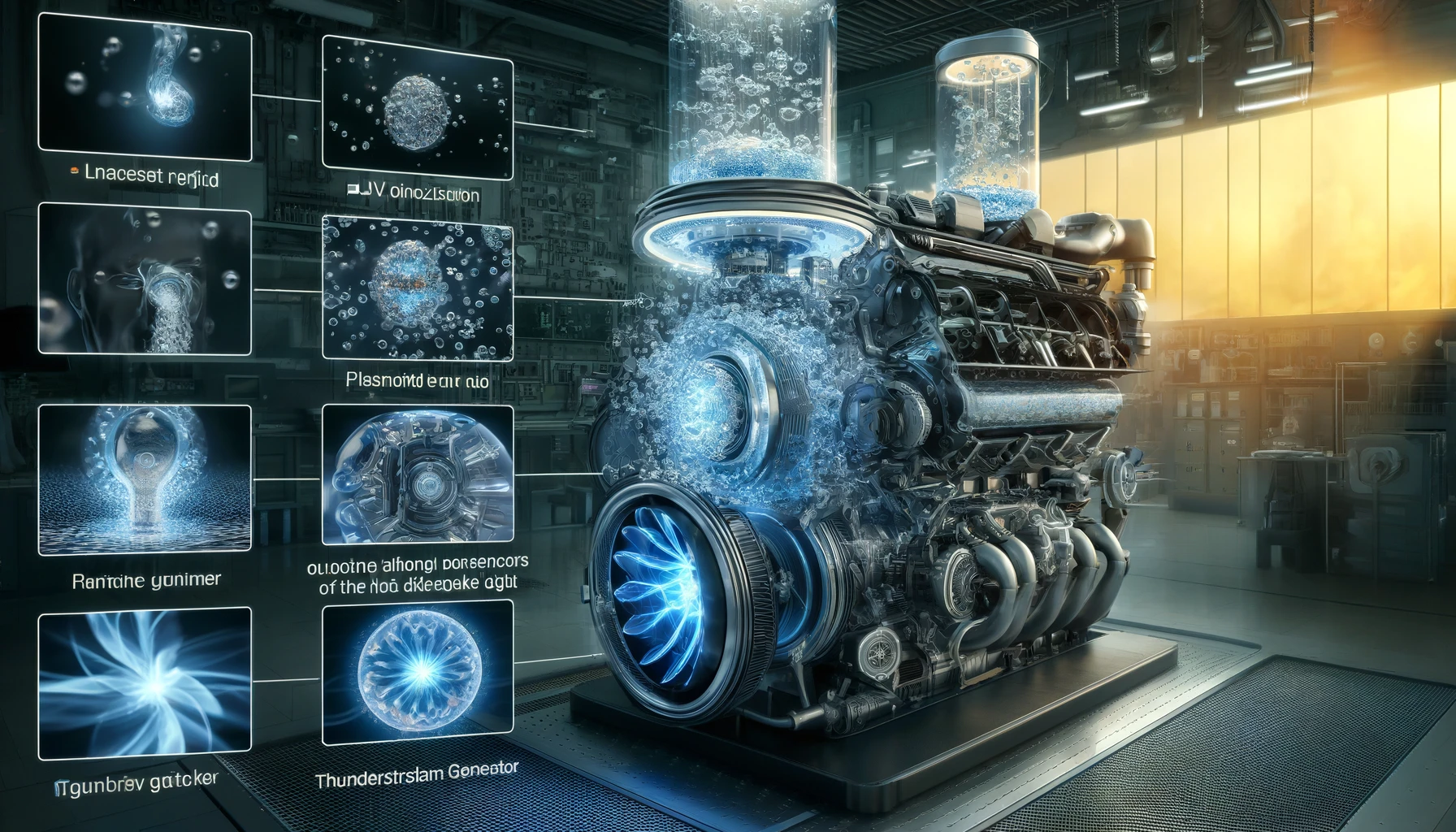Key Components:
- UV Air Ionization Unit: This is the first stage where incoming air is exposed to UV light, ionizing the air and creating a more reactive state conducive to the subsequent processes.
- Plasmoid Generator (Bubbler): In this second stage, the ionized air is passed through water, creating microbubbles that implode symmetrically, forming tiny plasmoids or ball lightning.
- Thunderstorm Generator Unit (Vadra): The final stage involves these plasmoids interacting with opposing vortexes of hot exhaust gases and cold intake air, leading to transmutation and energy conversion.
Process Breakdown:
- Engine Warm-Up: The engine is first warmed up with the retrofit turned off. Once it reaches operating temperature, the retrofit is engaged.
- Air Ionization: Air is pulled through the ionization chamber, where it’s exposed to UV light. This ionized air then moves into the bubbler.
- Plasmoid Formation: In the bubbler, the ionized air is forced through water, creating microbubbles. These bubbles implode and form plasmoids, tiny highly energetic structures.
- Vortex Interaction: The plasmoids are then drawn into the thunderstorm generator unit. Here, the hot exhaust gases create an expanding counterclockwise vortex, and the cold intake air creates a contracting clockwise vortex. These opposing vortexes do not collide in the traditional sense but interact to form a zero-point field or equilibrium state.
- Transmutation and Energy Conversion: As the gases pass through this equilibrium point, carbon in the exhaust gases is transmuted into oxygen, and additional hydrogen is produced. The plasmoids help facilitate this process by maintaining homeostasis and acting as catalysts for further reactions.
Outcomes:
- Increased Fuel Efficiency: By converting waste gases into useful elements, the engine can achieve a 15-40% increase in fuel efficiency.
- Emission Reduction: The process reduces harmful emissions, transforming carbon dioxide and monoxide into oxygen and other less harmful gases.
Other Possible Use Cases:
1. Automotive Industry
- Retrofit to Existing Vehicles: By retrofitting existing internal combustion engines in cars, trucks, and buses, the Thunderstorm Generator can significantly improve fuel efficiency and reduce emissions.
- New Vehicle Designs: Future vehicle designs can incorporate this technology from the outset, optimizing engines to fully integrate the Thunderstorm Generator.
2. Power Generation
- Electricity Plants: Power plants, especially those that burn fossil fuels, can use this technology to reduce carbon emissions and increase efficiency by converting waste gases into useful elements.
- Renewable Energy Enhancement: Integrating this technology with renewable energy sources, such as biomass plants, can enhance overall efficiency and reduce environmental impact.
3. Marine Industry
- Ships and Submarines: Marine vessels can benefit from retrofitting their engines with this technology to improve fuel efficiency, extend operational range, and reduce emissions, which is crucial for complying with international maritime pollution regulations.
4. Aerospace Industry
- Aircraft Engines: Jet engines and other aircraft propulsion systems can be adapted to use the Thunderstorm Generator, reducing fuel consumption and emissions in the aviation sector.
- Spacecraft: The technology could be used to create more efficient propulsion systems for spacecraft, potentially improving the sustainability of space missions.
5. Industrial Applications
- Manufacturing Plants: Factories and industrial plants that rely on combustion processes can integrate this technology to reduce waste, lower emissions, and improve overall energy efficiency.
- Chemical Processing: The technology can be adapted for use in chemical reactors to improve the efficiency of processes involving the transformation of chemical compounds.
6. Agriculture
- Farm Equipment: Tractors, harvesters, and other agricultural machinery can be retrofitted to improve fuel efficiency and reduce the carbon footprint of farming operations.
- Greenhouses: The technology can help manage greenhouse gas emissions within controlled agricultural environments, enhancing sustainability.
7. Residential and Commercial Heating
- Heating Systems: Home and commercial building heating systems can incorporate the Thunderstorm Generator to make them more efficient and environmentally friendly.
- Backup Generators: Residential and commercial backup generators can be optimized with this technology to reduce emissions and improve fuel efficiency during power outages.
8. Transportation Infrastructure
- Public Transportation: Buses, trains, and other forms of public transportation can utilize this technology to make mass transit more sustainable and cost-effective.
- Logistics and Delivery: Delivery trucks and other logistics vehicles can be retrofitted to reduce operational costs and environmental impact.
9. Environmental Remediation
- Pollution Control: The technology can be used in systems designed to capture and convert pollutants from industrial emissions, helping to clean the air and mitigate climate change.
- Waste Management: It can be integrated into waste management processes to convert harmful gases from landfills and other waste sites into less harmful substances.
10. Energy Storage and Conversion
- Hydrogen Production: The Thunderstorm Generator’s ability to produce hydrogen as a byproduct can support hydrogen fuel cell technology, providing a cleaner alternative to traditional fuels.
- Energy Grid Integration: It can be used to enhance the efficiency of energy grids by converting waste energy into useful forms that can be stored or redirected as needed.
Study Up On The Thunderstorm Generator

1. Educational Resources
- Books and Articles: Start with foundational texts and recent papers on related subjects like plasma physics, advanced energy systems, and low-energy nuclear reactions (LENR). Recommended readings include “The New Science of Heaven” by Robert Temple and peer-reviewed articles in journals like Nature.
- Online Courses: Enroll in online courses related to plasma physics, thermodynamics, and renewable energy systems on platforms like Coursera, edX, and Khan Academy.
2. Scientific Literature
- Research Papers: Access scientific papers through databases like Google Scholar, PubMed, and ResearchGate. Look for studies on plasmoid technology, ball lightning, and energy conversion.
- Journals: Subscribe to scientific journals that publish research on energy technologies and advanced physics, such as the Journal of Applied Physics and Physical Review Letters.
3. Networking and Collaboration
- Conferences and Workshops: Attend relevant conferences such as the Cosmic Summit or other scientific gatherings focused on new energy technologies and advanced research in physics.
- Research Institutions: Reach out to universities and research institutions that specialize in energy systems, plasma physics, and environmental science. Networking with researchers in these fields can provide valuable insights and collaboration opportunities.
4. Practical Experimentation
- DIY Projects: Engage in DIY experimentation by building prototypes of the Thunderstorm Generator. Follow guides and tutorials available from open-source researchers like those from the Martin Fleischmann Memorial Project.
- Lab Work: If you have access to a laboratory, conduct controlled experiments to replicate and study the Thunderstorm Generator’s processes. Ensure you have the necessary safety protocols and equipment.
5. Online Communities and Forums
- Discussion Groups: Join online communities and forums where enthusiasts and researchers discuss plasmoid technology and related topics. Websites like Reddit, Quora, and specialized forums can be great places to exchange ideas and seek advice.
- Social Media: Follow researchers, inventors, and organizations involved in this field on platforms like Twitter, LinkedIn, and YouTube for the latest updates and insights.
6. Non-Profit and Open Source Initiatives
- Strike Foundation: Connect with the Strike Foundation, the non-profit organization founded by Malcolm Bendall, which focuses on educating people about plasmoid technology. Participate in their open-source projects and access their educational materials.
- Martin Fleischmann Memorial Project (MFMP): Engage with MFMP’s open-source research. They provide extensive documentation, videos, and guides on similar technologies and experiments.
7. Academic Pursuits
- University Programs: Consider pursuing formal education in related fields such as electrical engineering, mechanical engineering, physics, or environmental science. Look for universities that have strong research programs in energy technologies and advanced physics.
- Research Grants and Scholarships: Apply for research grants and scholarships that support studies in renewable energy and innovative technologies. Funding can help facilitate deeper research and experimentation.
